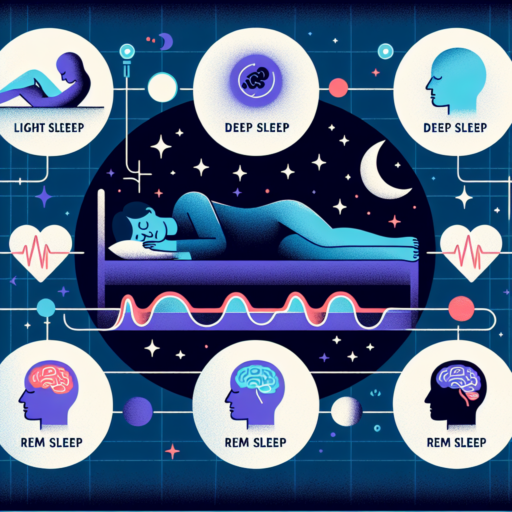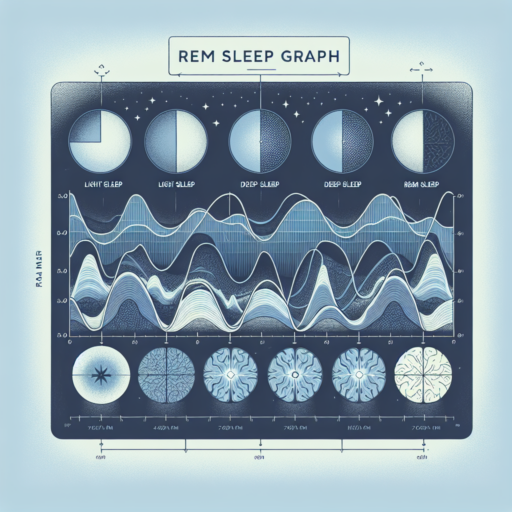Understanding REM Cycles: An In-Depth Introduction
The concept of REM (Rapid Eye Movement) cycles is crucial in the study of sleep physiology and psychology. REM cycles are distinct periods of sleep characterized by rapid movement of the eyes, low muscle tone throughout the body, and the propensity to dream vividly. This stage of sleep is thought to play a critical role in the processes of learning, memory consolidation, and emotional regulation. Understanding the intricacies of REM cycles not only enlightens us about our sleep patterns but also offers insights into our overall well-being.
REM sleep, typically accounting for 20-25% of an adult’s total sleep time, significantly influences our cognitive functions and mental health. The cycle begins roughly 90 minutes after falling asleep and recurs approximately every 90 minutes. Each cycle can vary in duration, often becoming longer as the night progresses. This phase is marked by several physiological changes, including increased brain activity, accelerated respiration and heart rate, and temporary paralysis of the muscles, a phenomenon known as REM atonia. This atonia is believed to prevent the body from acting out dreams, thereby serving a protective function.
Delving into the specifics, REM cycles are not just about dreaming; they are deeply intertwined with the process of memory consolidation. Studies suggest that during REM sleep, our brain meticulously processes and integrates the information acquired during the day, transforming it into long-term memories. This selective reinforcement of neural connections enhances learning and contributes to the fine-tuning of emotional responses. Hence, the quality and quantity of REM sleep are directly linked to our ability to learn new information and regulate emotions efficiently.
The Science Behind REM Sleep: Importance and Functions
The period of sleep known as Rapid Eye Movement (REM) serves as an essential component in our overall health and well-being. Understanding the science behind REM sleep helps to highlight its key importance and numerous functions. During this phase, our body experiences unique physiological states that are crucial for cognitive functions such as memory, learning, and emotional health.
The Role of REM Sleep in Emotional Regulation and Learning
REM sleep is particularly vital for the consolidation of memories and processing emotions. Studies have shown that during REM sleep, our brain is highly active, similar to when we are awake. This phase helps in organizing our memories for long-term storage and processing the emotional experiences of the day. It is during REM that the brain filters and connects experiences to our pre-existing knowledge base, aiding in learning and adaptation.
Moreover, the intensity of brain activity during REM sleep has been linked with improved problem-solving skills and creativity. By fostering an intricate dance of neuronal connections, REM sleep appears to reset our emotional compass, making it a critical period for emotional resilience and mental health.
Physical Health and REM Sleep
Apart from its significant psychological benefits, REM sleep is also closely connected with various aspects of physical health. It boosts immune system function, facilitates growth and repair of cells, and supports overall metabolic health. The unique state of muscle relaxation and increased brain activity during REM is thought to contribute to bodily recovery and maintenance. Hence, recognizing the functions of REM sleep
is paramount for encouraging practices that support quality sleep patterns, ultimately fostering both mental and physical well-being.
No se han encontrado productos.
How Many REM Cycles Should You Have Each Night?
The question of how many REM cycles you should have each night is important for understanding the structure and quality of your sleep. REM, which stands for Rapid Eye Movement, is a crucial phase in the sleep cycle that is associated with dreaming and memory consolidation. An average adult goes through multiple cycles of REM each night, which vary in length and frequency as the sleep progresses.
Typically, a healthy adult is recommended to aim for between 4 to 6 REM cycles per night. Each cycle lasts about 90 to 110 minutes, making up approximately 20-25% of your total sleep. As the night progresses, the length of REM stages increases, with the longest periods occurring in the final third of your sleep. Therefore, ensuring you have an adequate number of cycles is essential for cognitive functions and overall well-being.
The distribution and quality of these REM cycles are influenced by various factors such as age, sleep schedule, and lifestyle habits. For instance, infants may spend up to 50% of their sleep in the REM phase – highlighting the variability across different life stages. It is also worth noting that disturbances in achieving the recommended REM cycles can lead to feelings of grogginess and impair memory retention, thus highlighting the significance of maintaining a consistent sleep schedule.
Identifying and Improving Your REM Sleep for Better Health
Understanding REM sleep is crucial for overall health, as this sleep phase is deeply connected to the quality of your mental and physical well-being. Identifying whether you’re getting enough REM sleep involves looking out for signs of sleep disturbances or lack thereof, which include vivid dreams, as REM is the sleep phase wherein dreaming occurs most frequently. Moreover, a consistent sleep schedule and monitoring your sleep patterns can offer valuable insights into your REM sleep health.
To embark on improving your REM sleep, it is essential to focus on healthy sleep habits. This includes creating a bedtime routine that encourages relaxation and signals to your body that it’s time to wind down. Limiting exposure to screens and electronics before bed is also paramount since the blue light emitted can significantly hinder the transition into deep REM sleep. Furthermore, ensuring your sleeping environment is conducive to rest, with a comfortable mattress and minimal noise and light pollution, can make a profound difference.
Another strategy to enhance REM sleep is through diet and exercise. Certain foods and beverages, particularly those high in caffeine and sugar, can disrupt your sleep cycle and should be avoided in the hours leading up to bedtime. Conversely, regular physical activities have been shown to improve sleep quality, including the length and intensity of REM phases. Nevertheless, it’s recommended to complete any vigorous exercise a few hours before sleeping to give your body ample time to cool down.
The Impact of REM Sleep Deprivation: Symptoms and Long-Term Effects
REM sleep deprivation plays a crucial role in our overall health, and not getting enough of it can lead to significant consequences. This phase of sleep is responsible for various critical functions, including memory consolidation, emotional regulation, and learning processes. When deprived of REM sleep, individuals begin to exhibit noticeable symptoms that can affect their daily functioning and quality of life.
Symptoms of REM Sleep Deprivation
- Memory Issues: One of the immediate signs of insufficient REM sleep is difficulty remembering information. This aspect of cognitive function is often the first to suffer, making tasks and learning more challenging.
- Mood Swings: Emotional instability and increased irritability are also common, as REM sleep helps regulate emotions. The lack of it can hence lead to more pronounced mood swings and a decreased ability to cope with stress.
- Decreased Concentration: Without adequate REM sleep, individuals may find it harder to focus and pay attention, impacting both work and personal life.
Long-Term Effects of REM Sleep Deprivation
Chronically missing out on REM sleep can have more severe long-term effects on health. Extended periods of deprivation are linked to various mental health issues, including depression and anxiety. Physically, the risk for chronic conditions such as obesity, diabetes, and cardiovascular diseases increases. The cumulative impact of these effects underscores the importance of addressing REM sleep deprivation early on to maintain both mental and physical well-being.
Optimizing Your Sleep Environment for More Effective REM Cycles
The rapid eye movement (REM) cycle is a critical phase of our sleep, responsible for memory consolidation, emotional regulation, and the rejuvenation of the mind. Creating an ideal sleep environment is essential for facilitating longer, undisturbed REM cycles. This, in turn, can improve overall health, mood, and cognitive function. Optimizing your sleep environment involves a combination of factors, from the physical comfort of your sleeping space to the sensory inputs that can affect the quality of your sleep.
Ensure a Comfortable Sleep Surface
One of the first steps in optimizing your sleep environment is ensuring that your mattress and pillows support your body in a way that promotes comfort and prevents waking during the night. The right mattress should support your spine in its natural curve, reducing the risk of waking up due to discomfort. Likewise, pillows should keep your head and neck aligned with your spine. Investing in high-quality bedding materials can significantly enhance the comfort of your sleep surface, thereby promoting uninterrupted REM cycles.
Minimize Noise and Light Disturbances
External stimuli such as noise and light can drastically impact the quality of your sleep by interfering with the natural progression into deeper REM cycles. Utilizing tools such as blackout curtains or white noise machines can help in creating an ideal auditory and visual environment conducive to sleep. Additionally, minimizing the use of electronic devices before bedtime can reduce exposure to blue light, which is known to disrupt circadian rhythms and hinder the transition into REM sleep.
Maintain Optimal Temperature and Air Quality
The temperature and air quality of your sleeping environment can also have a profound effect on your ability to engage in effective REM cycles. The ideal bedroom temperature for most people ranges between 60-67 degrees Fahrenheit (15.5-19.4 degrees Celsius), as cooler conditions tend to support better sleep quality. Ensuring good air quality and adequate ventilation can further enhance sleep by reducing potential respiratory irritants and maintaining a comfortable humidity level. Considering the use of air purifiers or humidifiers can be beneficial in optimizing these conditions for an uninterrupted night’s sleep.
Techniques and Tools to Monitor and Enhance Your REM Sleep
Understanding and improving the Rapid Eye Movement (REM) phase of sleep is crucial for overall health and well-being. REM sleep, a vital sleep stage associated with dreaming, memory consolidation, and emotional regulation, can significantly impact your daily functionality and mental health. Enhancing REM sleep is not just a matter of increasing sleep duration but involves specific techniques and tools dedicated to improving the quality of this sleep stage.
Optimizing Your Sleep Environment
Creating a conducive sleep environment is the first step towards enhancing your REM sleep. Factors such as room temperature, noise level, and light exposure play a critical role in influencing sleep quality. Ensuring your bedroom is cool, quiet, and dark can significantly improve your sleep patterns. Utilizing blackout curtains or white noise machines are practical solutions for minimizing disruptions that can impede upon the REM stage.
Tracking and Analyzing Sleep
With the advent of technology, there are numerous tools available for monitoring sleep patterns and stages. Wearable devices like smartwatches and fitness trackers can provide insights into your sleep cycle, including the duration and quality of your REM sleep. Applications such as Sleep Cycle and DreamMapper delve deeper, offering detailed analyses and personalized recommendations on how to optimize your sleep schedule and environment for better REM sleep. Keeping a sleep diary can also be beneficial, as it makes it easier to identify patterns or habits that may be detrimental to achieving restful REM sleep.
Common Myths About REM Sleep Debunked
When it comes to understanding sleep, REM (Rapid Eye Movement) sleep is often surrounded by a sea of misinformation and myths. This crucial phase of our sleep cycle is sometimes misunderstood, leading to a plethora of misconceptions. By examining the evidence, we can separate fact from fiction and gain a better understanding of REM sleep’s role in our health and well-being.
One of the most prevalent myths suggests that adults need less REM sleep as they age. In reality, while it’s true that the distribution of sleep stages might change over a lifetime, REM sleep remains fundamentally important across all ages for cognitive functions and emotional health. This stage of sleep is responsible for a variety of critical processes, including memory consolidation and mood regulation, debunking the myth that its significance fades with age.
Another common misconception is that dreams only occur during REM sleep. While REM sleep is indeed associated with more vivid and narrative-driven dreaming, research has shown that dreams can also occur during other stages of sleep, albeit less frequently and with different characteristics. This understanding broadens our perspective on the complexities of the sleep cycle and the phenomenon of dreaming.
Lastly, there’s a belief that a lack of REM sleep can’t significantly impact one’s health. On the contrary, research indicates that disruptions in REM sleep can have profound effects on emotional and physical health, including increased risks for conditions like depression, obesity, and cardiovascular disease. This highlights the critical importance of maintaining healthy sleep patterns, including adequate REM sleep, for overall well-being.
Link Between REM Sleep and Memory Consolidation
Understanding the link between REM sleep and memory consolidation is essential for comprehending how our brains process and store information during rest. Rapid Eye Movement (REM) sleep, characterized by rapid movement of the eyes, is a crucial phase in the sleep cycle that plays a significant role in the cognitive processes related to memory. Studies have indicated that during REM sleep, the brain is engaged in activities essential for memory consolidation, the process by which short-term memories are transformed into long-term memories.
During REM sleep, increased brain activity is observed, particularly in areas involved in learning and memory, such as the hippocampus and neocortex. This suggests a critical period where the brain organizes and integrates new information with existing memory networks. Neuroscientific research supports the view that REM sleep facilitates the strengthening of neural connections necessary for embedding new knowledge and skills, making this stage of sleep invaluable for learning retention.
The intricate relationship between REM sleep and memory consolidation is also evident in how sleep disruptions can impair memory formation. Individuals who experience reduced or disturbed REM sleep often report difficulties with memory recall and learning efficiency. This correlation highlights the importance of adequate REM sleep in ensuring that the processes of memory consolidation are effectively carried out, emphasizing REM’s role in cognitive health and development.
Tips for Achieving Better REM Cycles: From Diet to Routine
The quality of our Rapid Eye Movement (REM) sleep can profoundly affect our health, mood, and overall well-being. Achieving better REM cycles is essential for mental restoration, memory retention, and emotional equilibrium. Here, we delve into practical tips that seamlessly integrate into your daily life, focusing on dietary habits and routines proven to foster deeper, more restorative REM phases.
Optimize Your Diet for Sleep
Eating habits play a crucial role in how well we sleep, especially when it comes to entering REM stages. To enhance these cycles, consider foods rich in magnesium, such as almonds and spinach, and those high in omega-3 fatty acids like salmon. Both nutrients have been linked to improved sleep quality. Additionally, incorporating complex carbohydrates like whole grains into your dinner can aid in this quest. They help increase the availability of tryptophan in the brain, which is used to produce serotonin, a precursor to melatonin—the sleep hormone. However, avoid heavy or high-fat meals close to bedtime, as they can disrupt your sleep cycle.
Establish a Sleep-Conducive Routine
Creating a pre-sleep routine that promotes relaxation and signals your body that it’s time to wind down can significantly enhance REM sleep quality. This might include activities such as reading under low light, practicing meditation or deep breathing exercises, and taking a warm bath or shower. The reduction of blue light exposure from screens at least an hour before bedtime is also vital; blue light suppresses melatonin production, making it harder to fall and stay asleep. Regular exercise during the day can further benefit sleep cycles but try to avoid strenuous workout close to bedtime.
Focus on Sleep Consistency
Maintaining a consistent sleep schedule is arguably one of the most influential factors in achieving better REM cycles. Going to bed and waking up at the same times each day, even on weekends, can significantly improve the quality of your REM sleep. This consistency helps regulate your body’s internal clock and can make falling asleep and waking up less of a hassle. Recognizing the personal optimal amount of sleep your body needs and consistently meeting this requirement is key to unlocking the restorative benefits of REM sleep.




